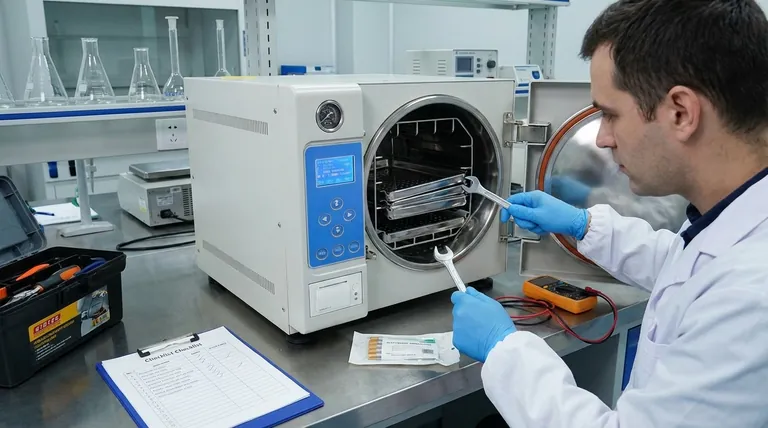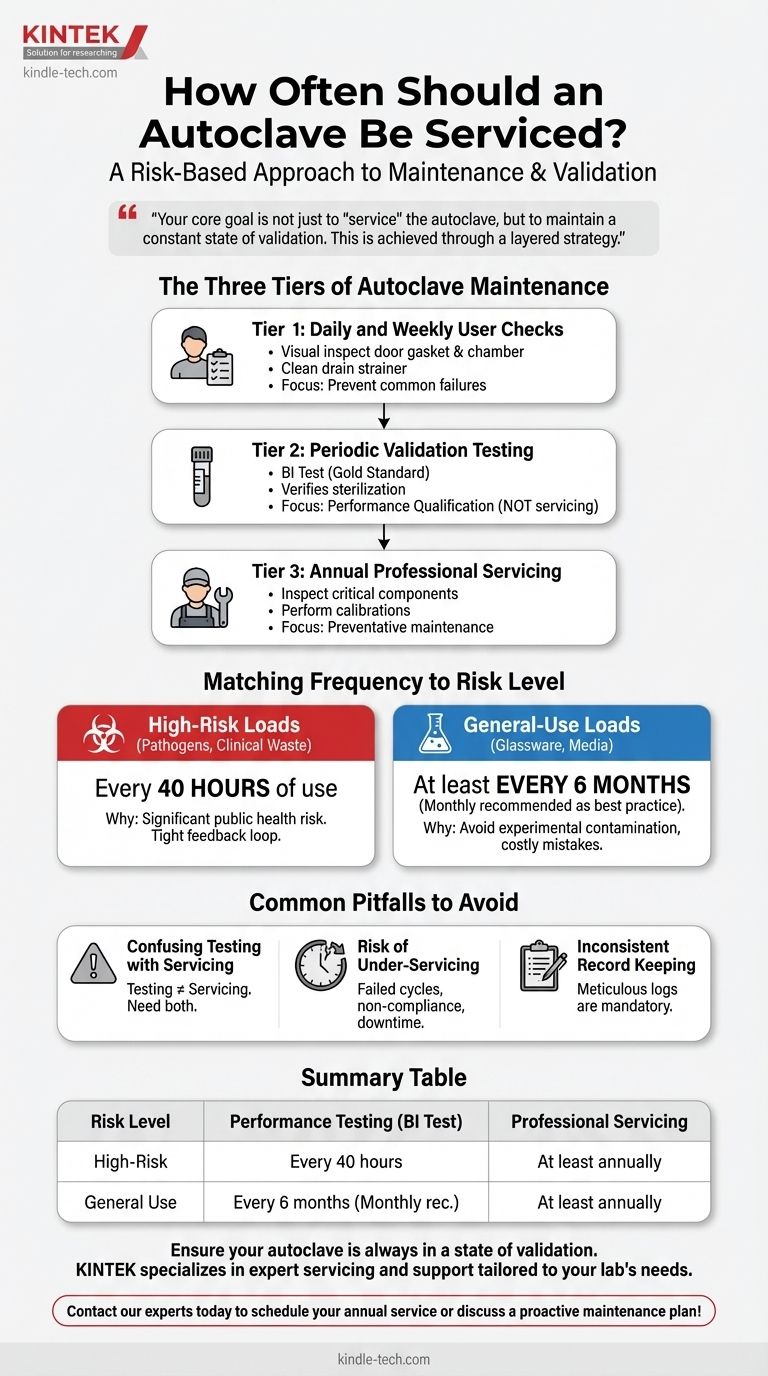An autoclave's required service frequency is not a single date on a calendar but is dictated by its usage, the materials being sterilized, and regulatory standards. For high-risk applications involving human pathogens or clinical samples, performance testing is required after every 40 hours of use. For autoclaves sterilizing general materials, testing is required at least every six months, supplemented by comprehensive annual servicing from a qualified technician.
Your core goal is not just to "service" the autoclave, but to maintain a constant state of validation. This is achieved through a layered strategy of daily user checks, risk-based performance testing, and annual professional maintenance.

The Three Tiers of Autoclave Maintenance
Effective autoclave management moves beyond a single annual appointment. It requires a multi-tiered approach where responsibility is shared between the daily operator and qualified service technicians.
Tier 1: Daily and Weekly User Checks
The operator is the first line of defense. Simple, consistent checks prevent most common failures.
Before each use, operators should visually inspect the door gasket for cracks or wear and ensure the chamber is free of debris. The chamber drain strainer should also be cleaned daily or weekly to prevent clogs that can impede sterilization.
Tier 2: Periodic Validation Testing
This is the process of formally verifying that the autoclave is achieving sterilization. This is not servicing; it is performance qualification.
The gold standard for this is a biological indicator (BI) test, which uses highly resistant bacterial spores to prove the cycle is lethal to microorganisms. The frequency of this testing is directly tied to risk.
Tier 3: Annual Professional Servicing
A qualified technician should perform a comprehensive service at least once a year. This is a preventative maintenance and calibration event.
During this service, the technician will inspect and test critical components like safety valves, control systems, and temperature and pressure sensors. They will also perform necessary calibrations to ensure the machine is operating to its specified parameters.
Matching Frequency to Risk Level
The "40-hour" or "six-month" rules are based on the potential consequences of a sterilization failure. Understanding the "why" behind these numbers is key to ensuring compliance and safety.
High-Risk Loads: The 40-Hour Rule
For autoclaves used to inactivate materials like human pathogens, blood, tissues, or clinical samples, validation testing must be performed after every 40 hours of use.
The reason for this high frequency is the significant public health risk. A failure to inactivate a pathogen could lead to exposure and infection. This frequent testing provides a tight feedback loop to catch any performance degradation immediately.
General-Use Loads: The Semi-Annual Baseline
For autoclaves sterilizing non-biohazardous materials like laboratory glassware, media, or instruments for research, performance testing is required at a minimum of every six months.
While a failure here is less catastrophic, it can result in costly experimental contamination and lost work. For this reason, many institutions adopt a more conservative monthly testing schedule as a best practice, even for general-use autoclaves.
Common Pitfalls to Avoid
Simply following a schedule is not enough. You must understand the context to avoid common and costly mistakes that create a false sense of security.
Confusing Testing with Servicing
Running a biological indicator test and getting a "pass" result is testing, not servicing. It confirms the autoclave worked correctly for that specific cycle but does not replace the need for professional maintenance to prevent future component failure.
The Risk of Under-Servicing
Stretching the time between servicing and testing can have severe consequences. These include failed sterilization cycles, non-compliance with health and safety regulations, premature equipment failure, and unexpected downtime that halts operations.
Inconsistent Record Keeping
Regulators and auditors require proof of both performance validation (BI test results) and professional servicing. Meticulous logs are not optional; they are a core component of a compliant autoclave management program.
How to Establish Your Autoclave Service Plan
Use this framework to build a robust and defensible plan tailored to your specific needs.
- If your primary focus is sterilizing high-risk materials (e.g., clinical waste, human pathogens): You must validate performance with a biological indicator at least every 40 hours of use and schedule annual professional servicing.
- If your primary focus is sterilizing general lab equipment (e.g., glassware, media): You must validate performance at least every six months, though monthly testing is the recommended best practice, alongside annual professional servicing.
- If you are setting up a new or recently repaired autoclave: You must perform an initial performance qualification with multiple successful BI tests before it is ever used for active loads.
A proactive and risk-based maintenance schedule is your best defense against sterilization failure and regulatory non-compliance.
Summary Table:
| Risk Level | Performance Testing (BI Test) | Professional Servicing |
|---|---|---|
| High-Risk (e.g., pathogens, clinical waste) | Every 40 hours of use | At least annually |
| General Use (e.g., glassware, media) | At least every 6 months (monthly recommended) | At least annually |
Ensure your autoclave is always in a state of validation. Don't risk sterilization failure, non-compliance, or costly downtime. KINTEK specializes in laboratory equipment and consumables, providing expert autoclave servicing, validation testing, and support tailored to your lab's specific needs.
Contact our experts today to schedule your annual service or discuss a proactive maintenance plan!
Visual Guide

Related Products
- Desktop Fast Laboratory Autoclave Sterilizer 35L 50L 90L for Lab Use
- Portable Digital Display Automatic Laboratory Sterilizer Lab Autoclave for Sterilization Pressure
- Desktop Fast Laboratory Autoclave Sterilizer 20L 24L for Lab Use
- Portable High Pressure Laboratory Autoclave Steam Sterilizer for Lab Use
- Laboratory High Pressure Steam Sterilizer Vertical Autoclave for Lab Department
People Also Ask
- Which autoclave is used in microbiology lab? Gravity Displacement vs. Pre-Vacuum Explained
- What is the temperature of autoclave in microbiology lab? Achieve Sterile Conditions with 121°C
- How do you autoclave lab equipment? A Step-by-Step Guide to Sterile Results
- What should be autoclaved in a lab? A Guide to Safe and Effective Sterilization
- What is an autoclave used for in a lab? Achieve Total Sterilization for Lab Safety and Integrity



















